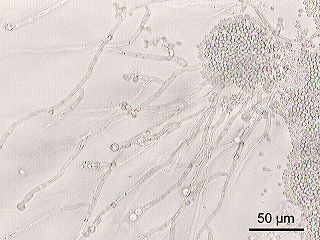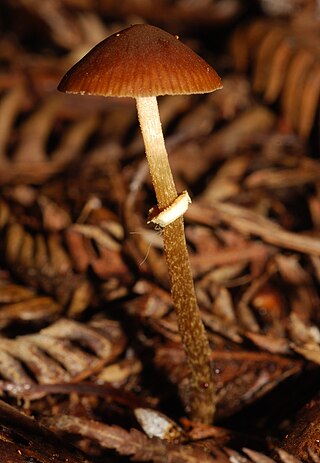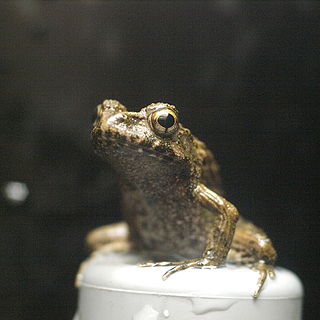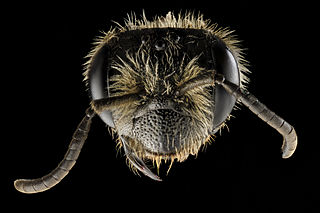
Rosa rugosa is a species of rose native to eastern Asia, in northeastern China, Japan, Korea and southeastern Siberia, where it grows on beach coasts, often on sand dunes. It should not be confused with Rosa multiflora, which is also known as "Japanese rose". The Latin word "rugosa" means "wrinkled", referring to the wrinkled leaves.

Candida is a genus of yeasts and is the most common cause of fungal infections worldwide. In fact, it is the largest genus of medically important yeasts.

Alnus incana, the grey alder or speckled alder, is a species of multi-stemmed, shrubby tree in the birch family, with a wide range across the cooler parts of the Northern Hemisphere. Tolerant of wetter soils, it can slowly spread with runners and is a common sight in swamps and wetlands. It is easily distinguished by its small cones, speckled bark and broad leaves.
The elm cultivar Ulmus 'Rugosa' [:'wrinkled', the leaves], was first listed in Audibert's Tonelle (1817), as "U. campestris Linn. 'Rugosa' = orme d'Avignon [Avignon elm] ", but without description. A description followed in the Revue horticole, 1829. Green (1964) identified this cultivar with one listed by Hartwig and Rümpler in Illustrirtes Gehölzbuch (1875) as Ulmus montana var. rugosaHort.. A cultivar of the same name appeared in Loddiges' catalogue of 1836 and was identified by Loudon in Arboretum et Fruticetum Britannicum (1838) as Ulmus montana var. rugosaMasters, Masters naming the tree maple-bark elm. Ulmus montana was used at the time both for wych cultivars and for some cultivars of the Ulmus × hollandica group.

Pholiotina rugosa is a common mushroom which is widely distributed and especially common in the Pacific Northwest. It grows in woodchips, flowerbeds and compost. It has been found in Europe, Asia and North America. It contains the same mycotoxins as the death cap. It is more commonly known as Conocybe filaris as this is the name it is likely to appear under in field guides. However, Conocybe filaris is a junior synonym of Pholiotina rugosa. Pholiotina rugosa has also been placed in the genus Conocybe, but its morphology and a 2013 molecular phylogenetics study place it in the genus Pholiotina. Pholiotina fimicola, which grows on dung and rich soil in North America, is a possible synonym. Pholiotina arrhenii has also been considered a possible synonym, but a molecular phylogenetics study found it to be a distinct species.

The Japanese wrinkled frog is a species of true frog native to Japan and introduced to Hawaii in the late 19th century. It has sometimes been regarded as a single species with the Imienpo Station frog which is found on the East Asian mainland. The two species are distinguished from others by their rough and uneven skin. It lives and breeds in various freshwater environments, including ponds, streams and wetlands. The IUCN does not consider this species to be faced by any significant threats.

The oblong turtle, also known commonly as the narrow-breasted snake-necked turtle and the southwestern snake-necked turtle, is a species of turtle in the family Chelidae. The species is endemic to the southwestern part of Western Australia.

Limnophila is a genus of flowering plants in the family Plantaginaceae. It is distributed in tropical and subtropical regions of Africa, Asia, Australia, and the Pacific Islands. Species are known commonly as marshweeds.

Solidago rugosa, commonly called the wrinkleleaf goldenrod or rough-stemmed goldenrod, is a species of flowering plant in the family Asteraceae. It is native to North America, where it is widespread across eastern and central Canada and the eastern and central United States. It is usually found in wet to mesic habitats.

Dalquestia is a genus of harvestmen in the family Globipedidae from North America.
Donacia rugosa is a species of aquatic leaf beetle in the family Chrysomelidae. It is found in North America.

Trirhabda is a genus of skeletonizing leaf beetles in the family Chrysomelidae. There are more than 30 described species in Trirhabda. They are found in North America and Mexico.
Phyllophaga rugosa, the rugose June beetle, is a species of scarab beetle in the family Scarabaeidae. It is found in North America.
Trichordestra rugosa, the wrinkled trichordestra, is a species of cutworm or dart moth in the family Noctuidae. It is found in North America.
Ophraea is a genus of skeletonizing leaf beetles in the family Chrysomelidae. There are about eight described species in Ophraea. They are found in North America and the Neotropics.

The wrinkled miner bee is a species of miner bee in the family Andrenidae. Another common name for this species is the rugose andrena. It is found in North America.
Dalquestia formosa is a species of harvestman in the family Globipedidae. It is found in North America.
Idionella rugosa is a species of dwarf spider in the family Linyphiidae. It is found in the United States.
Eusattodera is a genus of skeletonizing leaf beetles in the family Chrysomelidae. There are about six described species in Eusattodera. They are found in North America.

Rhynchospora rugosa, known by the common name of claybank beaksedge, is a member of the sedge family, Cyperaceae. It is a perennial herb, native to Central and South America.












